In her life,
as in her art, Marie Wilson's drive to explore has led her
from rural California to the Surrealist circle of artists
and poets in Paris, to family life in Greece, and eventually
back to Oakland, California where she resides for part of
each year. Her life and art encapsulate the themes and concerns
of the past century.
Susan Moulton,
professor of art at Sonoma State University, and her students
Susan Foley and Kendra Gross met with Marie Wilson and her
husband in their home in Oakland, California. Susan Moulton
has also visited their homes in Paris, Athens and Madouri,
Greece. Marie Wilson is a distinguished older woman whose
life and artistic production place her at the epicenter of
twentieth-century modernism. Like many women, her significant
contributions have been largely overlooked by the mainstream,
but her complex artistic work and magnificent personal example
have inspired many during the past sixty years of her professional
career.
(Throughout the
article, Marie's words are italicized and Susan Foley's commentary
is in roman type.)
I was born in 1922 in a very romantic little gorge, a
short distance from a town called Cedarville (in Modoc County,
California) and raised in a small pioneer-type house. My grandfather
was a minister in the church, and my English grandmother was
a very refined parsonís wife. He had a wonderful collection
of Indian artifacts.
Marie credits this for her lifelong
fascination with Native American imagery.
The only time I saw my biological
father alive, he was passing by in a car. The second
time I saw him was at his funeral. I must have been about
twelve years old when he died at age forty-two. I remember
passing by him at the funeral and seeing a very handsome man.
I didnít see any photograph of him until I was sixty-five
years old. Last year, someone sent me a few more photos, and
I also got to see a picture of the paternal grandmother I
never knew.
I was about six years old when
my mother married my stepfather--the head of a cattle company--whose
last name was Wilson.
They lived a life full of cowboys
and horses and ranch animals, and Marie still vividly remembers
how her stepfather drove wild horses through town and over
the mountains to the Nevada plains, where they would be rounded
up for the rodeos.
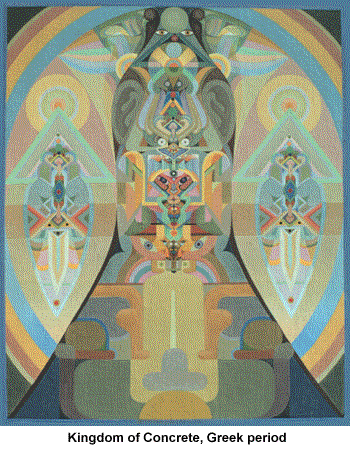

I think I was born an artist. As long as I can remember,
I had a pencil and colors in my hand. I had saved a lot of
the early things I made. The house had a gabled roof, and
I hid them in a little area in the attic where nobody ever
went; but when I went back years later they were gone. So
I never got to see the things that I made with such love as
a young child.
I left Cedarville to go to Sacramento
Community College and of course I majored in art. Then I won
a scholarship to Mills College, which I attended from 1942
to 1944, and graduated with a B.A. in Fine Arts.
After college, I didnít want to
go home. I went to Los Angeles, where my grandfatherís sister
lived, and got a job in a factory--a war factory, where we
made guns. I broke records there and everyplace I worked.
A beautiful old woman doctor at Mills had said that if I didnít
slow down they would take me out of there in a box.
I have never slowed down. I drove myself for years, and I
still do.
In 1945 1 won a teaching fellowship
at Mills. I stayed one year and then went to the University
of California at Berkeley. I got my Master of Arts degree
in 1948, then taught at Sacramento High for two years. After
that I went to the Oakland Museum and taught regional scholarship
students.
My art training had been conventional
up until that point. Then I met Jean Varda, who became my
mentor and a great presence in my life. In my generation everybody
knew him. Varda was an adventurer, an expatriate Greek who
had worked in Paris in a studio with artists such as Braque
and Miro. The modern artists were breaking up the forms and
the symmetry, but they never really knew how to teach. They
would just show us paintings and say, "Do it like this." Having
lived in Europe, Varda had the background to teach me the
language of modern painting. When I came back in 1968 as a
re-entry student at the junior college, I saw that professors
there had reduced modern art to certain laws of construction.
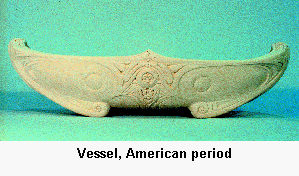
I went to Europe in 1952. I thought
I was going to Paris for six months and wound up staying in
Europe for seventeen years. I had met the artist Wolfgang
Paalen at a party on Vardaís houseboat in Sausalito. I
followed Paalen to Paris, where he took me to meet André
Breton. We went to many parties where there were people like
Giacometti, Max Ernst, Marcel Duchamp, Jean Arp and other
well-known surrealist artists. In such distinguished company,
I felt like a greenhorn from rural California.
The Surrealists were intellectuals
much older than Marie, and she wasnít yet fluent in French.
Despite the fact that she was well-educated and that they
were all very gracious to her, she remembers "groping for
self-worth in a manís world." I was a "femme-enfant," she
remembers--insecure yet embraceable because "I was young and
beautiful and well-dressed." In fact, Marieís initial experience
was similar to that of many women who came to Surrealism.
Generally in the dawn of their artistic careers, many were
introduced through personal involvement with a male member
of the movement, and then drawn in by Surrealismís reliance
on what could be described as feminine creativity, intuition
and the expression of a deeply personal reality. While she
arrived too late to be recognized as one of the movementís
prominent stars, Marie was at its nucleus during her time
in Paris, as a result of her very close and enduring friendship
with Breton and his wife Alisa. 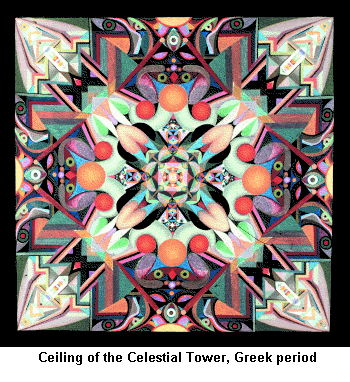
That summer, Marie and Paalen stayed
with the Bretons at their home in the thirteenth century village
of Saint Cirque La Popie, visiting ancient castles, studying
birds and butterflies, collecting stones and playing Surrealist
games to stimulate the imagination.
André Breton had
a wonderful personality. He had a magical magnificence about
him. Breton would always read his poetry to us. He had a wonderful
sort of passion and dedication.
Breton became something of a father
figure to Marie that summer, encouraging her to paint and
introducing her to the work of other Surrealists. They shared
an interest in the "psychopathological art" of the mentally
ill, which Breton regarded as truly authentic because it was
motivated only by the patientís need to express his or her
inner world. Closely related to such "asylum art" was the
work of the "medium painters," who painted in a trancelike
state in response to an inner voice. Breton owned many such
works, and Marie was most captivated by the symmetrical work
of two painters in particular.

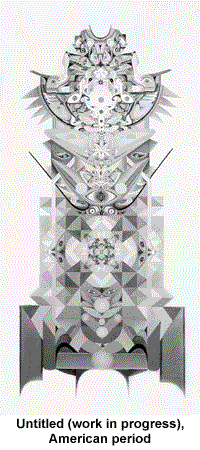 In
Paris, I was introduced to the symmetry of Joseph Crépin
and Augustin Lesage. Their work opened up a vision for me,
and within a year or two my work became completely symmetrical.
Symmetry was not at all popular among modern artists. I remember
a friend saying to me, "You are not going to repeat this same
thing on the other side?" At first I thought of symmetry as
a weakness, but I found out that not everybody has this. When
I look at an empty canvas, I go to the center automatically.
Usually I start a little above center, and draw a dot or maybe
a little shadow there--something. Then I put another bit to
the right and to the left, and then above and then below.
Itís like a cross. I work like that, as if I were making lace.
I invent it as I go. I am not starting with an idea. I donít
know where or what I am going to do when I begin a drawing
or a painting. As the drawing or painting develops, something
of modern art weaves itself into what I am doing.
In
Paris, I was introduced to the symmetry of Joseph Crépin
and Augustin Lesage. Their work opened up a vision for me,
and within a year or two my work became completely symmetrical.
Symmetry was not at all popular among modern artists. I remember
a friend saying to me, "You are not going to repeat this same
thing on the other side?" At first I thought of symmetry as
a weakness, but I found out that not everybody has this. When
I look at an empty canvas, I go to the center automatically.
Usually I start a little above center, and draw a dot or maybe
a little shadow there--something. Then I put another bit to
the right and to the left, and then above and then below.
Itís like a cross. I work like that, as if I were making lace.
I invent it as I go. I am not starting with an idea. I donít
know where or what I am going to do when I begin a drawing
or a painting. As the drawing or painting develops, something
of modern art weaves itself into what I am doing.
Amidst the dreamlike chaos of the
myriad forms that populate Marieís works, an underlying symmetrical
framework maintains a heraldic sense of order, much like the
order that underlies the randomness of nature. It creates
a stability that comforts in the face of the unexpected. Whether
suggestive of insects or animals, gargoyles or Mayan masks,
all forms align along a totemic central axis like chakras
along the spinal column of the composition.
Do you know the stories of Crépin
or Lesage? Crépin claims he heard a voice that told
him that if he painted so many paintings, the war would be
over. When he got to that number, the war was over. Lesage
was a coal miner. He was in the mines and heard a voice that
said, "You are going to be a painter." He didnít think much
about it. Time went on, and the voice told him to go to a
certain place and get certain art materials. Then it told
him to get a large canvas. He felt so very embarrassed to
have such a big canvas that he went home through the back
alleys. Wonderful, extraordinary images came to him that became
big birds or people.
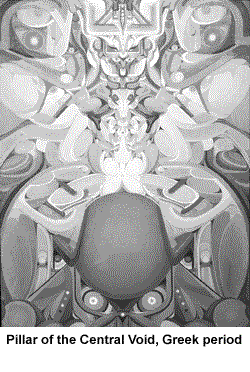

I was very self-conscious in Paris. In America we donít
kiss and shake hands so much. There was a little restaurant
in Paris where the sixteen Surrealists who lived there would
congregate. Every time I went there for a meal, they would
each shake my hand--sixteen handshakes. I had to greet
them this way, and when I finished my meal I had to shake
the same hands another sixteen times. I used to get very tense.
I had no experience of this relaxed graciousness where you
could kiss people on the cheeks and shake hands like that.
Paalen knew a man named Kirk who wrote a book
on magic, and we stayed at his place. Underneath the first
landing was a kitchen with an elevator for taking food up.
Up on the first floor we had our meals and social life.
On another mezzanine were the bedroom and the bath; on the
very top was Kirkís big studio. We lived there for some time,
and finally Paalen traveled back to Mexico.

Before leaving, Paalen had given me a letter of introduction
to go see Picasso because they had been friends. Like everybody
else, I admired Picasso and wanted to meet him. He received
me very nicely, and let me work in his studio. I felt
a little inhibited his presence and sometimes took the things
I was working on back to my hotel room so he wouldnít see
them. I could work there very easily, but when I brought them
back to his studio I felt shy. He liked what I did,
and paid for sending them back to me in Paris.
I lived ten years in Paris altogether.
After I was there for a year or two, Varda took me to a big
party with some of his fellow Greek artists and writers, and
Nanos Valaoritis (now Marieís husband) happened to be there.
When Picasso invited me back to his studio to work again,
Nanos didnít want me to go, so I stayed in Paris.

During the time between Paalenís departure and her introduction
to Nanos, Marieís work had been exhibited with that of the
other Surrealists at the Salon de Mai and in Bretonís Paris
gallery, A LíEtoile Scelle. Breton had also included reproductions
of her work in issues of his Surrealist Review from
time to time, yet she was still living a meager existence
on the eighty dollars per month she received from the rental
of her house in Oakland. The paintings "Table of Divination,"
"Owl Spirit," "Palace of the Setting Sun" and "The Rise of
the Celestial Monkey" were among the notable works shown in
1955 when she had her one-woman exhibition at Bretonís gallery.
That summer, on her first visit to Greece with Nanos, she
created a series of six lithographs that were published as
the book Terre de Diamant ("Land of the Diamond") with
text by Nanos. By now employing automatism exclusively (a
process of accessing the unconscious without regard to logic
or meaning) and working completely symmetrically, the lithographs
were "done with an affinity to the cosmic sacred."
Itís very nerve-racking,
because of the intensity of concentration. I never erase or
change anything, even in my pencil drawings. My work is like
charting out an unknown territory.
Later, drawings produced in this
manner were published as illustrations and frontispieces for
volumes of Nanosí poetry as well as that of Andreas Ambirikos,
Manda Aravantinou, Octavio Paz and Philip Lemantias.

Nanos and Marie lived together for six years, eventually marrying.
They have been together now for over forty years.
Six months pregnant with our first
child Katerina, I went with Nanos to Greece. Nanos is
from a very comfortable family. They own a very nice apartment
in Athens and a marvelous big island. He had an aunt with
a beautiful place in Spetsus, an island forty-five minutes
away. We stayed there for about a year, and then we got our
own place.
In the next six years they had two
more children (Zoe and Dino) and, with the help of hired domestics,
Marie was able to paint regularly despite the demands of motherhood.
"Kingdom of Concrete," "Pillar of the Void" (cover) and "Ceiling
of the Celestial Tower" were among the significant works produced
during this period. Throughout the 1960s her work was shown
at galleries in Paris and Venice. Then in 1967 a fascist dictatorship
seized control in Greece. Nanos was offered a teaching position
at San Francisco State University, and they returned to live
in Marieís Oakland home.
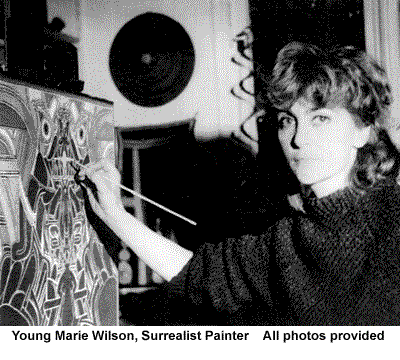

Back in the United States, it was difficult for Marie to find
time for her art, and the space in the house was taken over
by young children. Like many women with children, there was
no room for her to call her own.
I would set up my easel here and there,
and would come back and find it on the floor. "Who knocked
that over?" I remember my son running around the fireplace
with a skateboard.
Although it was wonderful to have
this place in America, it was not my ideal. My ideal was a
structure on top of a hill. I want to see the sun coming up
through one door and going down through the other. I see my
bed there, and where my shoes are, and where my clothes are.
I am ritualistic in nature. Itís really been hard for
me to work in space thatís not symmetrical. I want to live
symmetrically.
In 1974, Marie had a show at
Gallery Art Things in Berkeley. Shortly thereafter, she renewed
her teaching credential so that she could work as a substitute
teacher and enrolled in ceramics classes at the local community
college. These allowed her to have a life outside the home.
"Ceramics class was like having a studio and free instruction
whenever I wanted it." Inspired by her newfound freedom, she
decorated her vessels with the same intriguing imagery that
she poured out in her paintings.
After we lived seven years in
the United States, the dictatorship in Greece ended (1974).
We stayed in the Bay Area one more year, and then went back
to Paris for two years while Nanos was on sabbatical. After
the sabbatical, the family returned to the Bay Area. Eventually,
we visited our island of Madouri for the first time since
the dictatorship.
The family then began spending summers
in Greece. In 1983, Marie participated in a Surrealist show
in Ohio, and the following year Lawrence Ferlinghetti invited
her to have a one-person show at City Lights Books in San
Francisco. While finding space to paint in Oakland is still
a problem, Marie has continued with her ceramic work there
through the years, reserving painting for the summers spent
on Madouri. For a while she even found an old church on the
tiny island where she could paint in solitude.
I laid the chairs out where I
would sit. I laid the paints out in a cross. I had something
on the floor where I could lie down when I wanted to rest.
Everything was oriented like a cross, and it was wonderful.
It was the most natural thing to do. I was terrified all the
time that a priest or somebody would stop me, but nobody ever
did.
Now that the church is being restored.
Marie is without a painting studio, but she has plans to rearrange
the Oakland house to accommodate her need for private space.

I used to do exercises where I would look at the horizon
at night. I would go up, up, up and then come back. I would
go to the horizon and then down into the Earth--down, down,
down. It was a serious meditation, and it was also spontaneous.
I never shared it with anybody, but I think this may have
stimulated my imagination.
I donít worry about the forms.
You might see forms like eyes, but you wonít know if itís
a face thatís facing you or a profile. This is almost like
a face of a woman here, and then it goes up and becomes a
bird and a crown. I was brought up with animals. This
looks like horns coming out of an animal. This piece has got
a face here, something like a torso, a pelvis and legs. There
is something like an energy, a sexual energy that comes here
and opens up. Sometimes it orbits, and sometimes it floats
on a sea into nothingness.
For me, the thing is not to care
where the images come from but to be devoted--to have a devotion
for the path, for the unexplored, for the unknown.